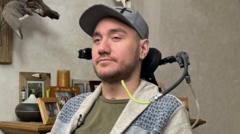The story of Noland Arbaugh, who utilizes a Neuralink brain chip to regain some independence after paralysis, explores both the potential benefits and serious privacy concerns of this emerging technology.
**Neuralink's Brain Chip: A Leap into Mind-Controlled Technology**

**Neuralink's Brain Chip: A Leap into Mind-Controlled Technology**
A paralyzed Arizona man demonstrates the groundbreaking potential of Neuralink's brain implant, marking a significant milestone in neurotechnology.
Noland Arbaugh, a 30-year-old man from Arizona, made headlines recently as the first person to receive a Neuralink brain implant, developed by Elon Musk's neurotechnology firm. This device, capable of translating thoughts into computer commands, offers Noland a chance at regaining some independence eight years after a diving accident left him paralyzed.
For many, the idea of a chip implanted in the brain seems like a concept reserved for science fiction, yet for Noland, it is a life-altering reality. He expressed awareness of the risks involved, stating that participating in this groundbreaking procedure is a way to contribute to scientific understanding, regardless of the outcome. Noland's condition drastically limited his ability to perform everyday activities, leading to frustrations over a lack of control and privacy that accompany such severe disability.
Neuralink's brain-computer interface (BCI) detects electrical impulses generated by thought, translating them into digital commands. Experts recognize the implications of Noland's successful implant, but there are serious safety, ethical, and privacy concerns related to the invasive nature of such procedures.
The high profile nature of Neuralink, chiefly due to Musk's involvement, has brought both investment and scrutiny to the technology's potential. Experts view the development as a monumental step forward in understanding brain function, despite the unclear long-term effects of the technology.
Upon waking from surgery, Noland's ability to control a cursor on a computer screen with mere thoughts was astonishing. As he adapted to the device, he rediscovered activities that he once enjoyed, such as playing chess and video games. The technology has not been entirely seamless, however; at one point, Noland experienced a disconnection from the device, highlighting potential issues with reliability.
As various companies, including Synchron, also explore brain-interface technologies, the industry is rapidly evolving. Synchron's innovative Stentrode device presents a less invasive alternative, indicating a broader trend in neurotechnology development. Users of these technologies report life-changing capabilities, like operating immersive devices or controlling external environments.
For Noland, there are uncertainties ahead; he has committed to a six-year research study with the Neuralink chip, and his future use of the technology remains undetermined. Despite this, he remains optimistic and believes in the untapped potential of brain-computer interfaces to enhance not just his own life, but countless others suffering from similar disabilities. "We know so little about the brain," he reflects, "and this is allowing us to learn so much more."
For many, the idea of a chip implanted in the brain seems like a concept reserved for science fiction, yet for Noland, it is a life-altering reality. He expressed awareness of the risks involved, stating that participating in this groundbreaking procedure is a way to contribute to scientific understanding, regardless of the outcome. Noland's condition drastically limited his ability to perform everyday activities, leading to frustrations over a lack of control and privacy that accompany such severe disability.
Neuralink's brain-computer interface (BCI) detects electrical impulses generated by thought, translating them into digital commands. Experts recognize the implications of Noland's successful implant, but there are serious safety, ethical, and privacy concerns related to the invasive nature of such procedures.
The high profile nature of Neuralink, chiefly due to Musk's involvement, has brought both investment and scrutiny to the technology's potential. Experts view the development as a monumental step forward in understanding brain function, despite the unclear long-term effects of the technology.
Upon waking from surgery, Noland's ability to control a cursor on a computer screen with mere thoughts was astonishing. As he adapted to the device, he rediscovered activities that he once enjoyed, such as playing chess and video games. The technology has not been entirely seamless, however; at one point, Noland experienced a disconnection from the device, highlighting potential issues with reliability.
As various companies, including Synchron, also explore brain-interface technologies, the industry is rapidly evolving. Synchron's innovative Stentrode device presents a less invasive alternative, indicating a broader trend in neurotechnology development. Users of these technologies report life-changing capabilities, like operating immersive devices or controlling external environments.
For Noland, there are uncertainties ahead; he has committed to a six-year research study with the Neuralink chip, and his future use of the technology remains undetermined. Despite this, he remains optimistic and believes in the untapped potential of brain-computer interfaces to enhance not just his own life, but countless others suffering from similar disabilities. "We know so little about the brain," he reflects, "and this is allowing us to learn so much more."



















